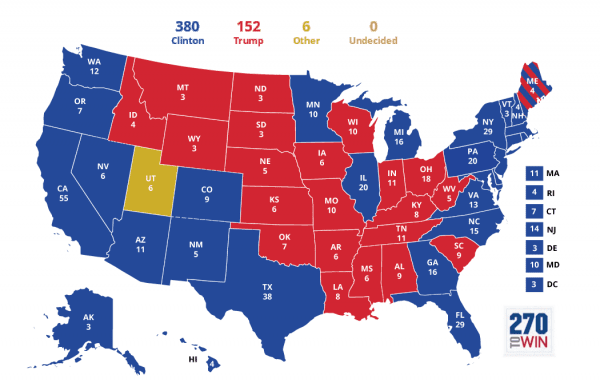Maps Of the Future

My latest column at The Week is about why I think it would be good if Trump wins some traditionally blue and purple states even as Clinton wins some traditionally red states:
[W]hat the country needs is a clear and decisive repudiation of Trump that also demonstrates that his message struck a chord beyond the precincts of Appalachia — a victory for Clinton that also contains a warning about the dangers to come if Trump’s legitimate issues are not addressed, and a loss for Republicans that also points to a more promising future under a different standard-bearer.
For a model of what such a loss would look like, consider not the blowout elections of 1972 or 1964, but the election of 1896.
For the 20 years prior to that famous election, the Democrats had done moderately well for themselves by nominating moderate candidates from the mid-Atlantic states (Samuel Tilden was from New York, as was Grover Cleveland; Winfield Scott was from Pennsylvania). They won some elections, and they lost some elections — and when they lost, it was by the narrowest of margins (indeed, they twice won the popular vote but lost the Electoral College).
But there were unaddressed issues bubbling that threatened the stability of the parties as they stood. In particular, America’s farmers were suffering severely under the prevailing hard-money policy that President Cleveland’s Democrats shared with the Republicans, and there was a pervasive anxiety about how mass immigration was changing both the character of the country and the distribution of the era’s economic gains.
In 1896, the Democrats broke with what had been their winningest formula, and nominated a populist champion, William Jennings Bryan. Bryan ran on a platform of bimetallism — an inflationary policy that would help indebted farmers at the expense of creditors — and against the banking interests on the East and West Coasts. And he personally represented a notion of what a “real American” was, or ought to be: white, Protestant, and oriented toward the countryside.
Bryan lost — and lost decisively. But he also won states that no Democrat had won since the Civil War — Kansas, Nebraska, and Colorado — along with new states like Washington, Montana, and Utah. Bryan gave representation and a voice to those who were losing ground in the era of the robber barons. And while McKinley’s coalition was the coalition of the future, a version of Bryan’s coalition — one that more comprehensively added Northern industrial workers — represented the future of his party.
Today, America’s industrial laborers are in a somewhat analogous position to farmers in Bryan’s day. And while Trump is no Bryan, his explicit appeal to those voters, and declaration that he would be their voice, deserves electoral recognition. Both parties need to be put on notice that there is a set of voters, and a set of issues, that are up for grabs, and that there is opportunity as well as risk involved in courting them.
So if had my druthers, on Nov. 8, the map will look something like this:
Go there to read more about why I think such a state swap would be valuable.
Comments